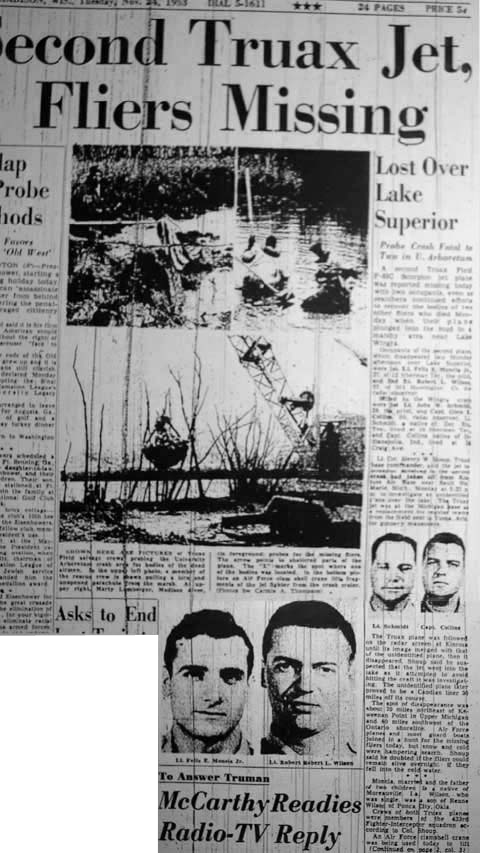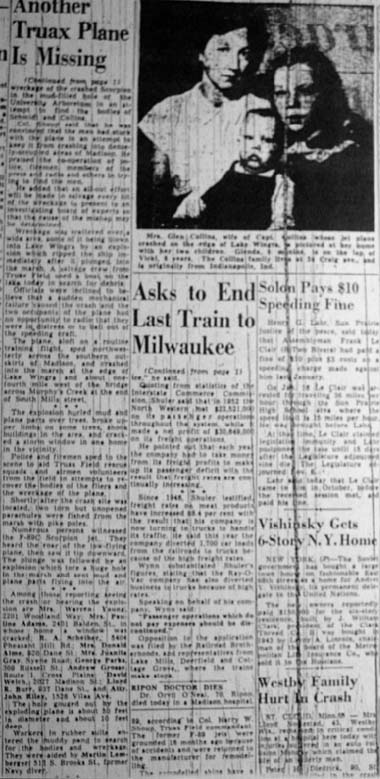Second Truax Jet, 2 Fliers Missing
The following News Article was published in the Capital Times in Madison, WI, on Tuesday, November 24, 1953.
Second Truax Jet, 2 Fliers Missing
Lost Over Lake Superior
Probe Crash Fatal to Two in U. Arboretum
A second Truax Field F-89C Scorpion jet plane was reported missing today with two occupants, even as searchers continued efforts to recover the bodies of two other fliers who died Monday when their plane plunged into the mud in a marshy area near Lake Wingra.
Occupants of the second plane, which disappeared Monday afternoon over Lake Superior, were 1st Lt. Felix E. Moncla, Jr., 27, of 12 Sherman Ter., the pilot, and 2nd Lt. Robert L. Wilson, 22, of 301 Huntington Ct. the radar observer.
Killed in the Wingra crash were 1st Lt. John W. Schmidt, 28, the pilot, and Capt. Glen E. Collins, 30, radar observer. Lt. Schmidt, a native of Del Rio, Tex., lived at 10 Sherman Ter., and Capt. Collins, native of Indianapolis, Ind., lived at 24 Craig Ave.
Lt. Col. Henry W. Shoup, Truax base commander, said the jet interceptor involved in the second crash had taken off from Kinross Air Base near Sault Ste. Marie, Mich., Monday at 5:22 p.m. to investigate an unidentified plane over the lake. The Truax jet was at the Michigan base as a replacement for regular teams from the field sent to Yuma, Ariz. for gunnery maneuvers.
The spot of disappearance was about 70 miles northeast of Keweenan Point in Upper Michigan an 40 miles southeast of the Ontario shoreline. Air Force planes and most guard boats joined in a hunt for the missing fliers today, but snow and cold were hampering search. Shoup said he doubted if the fliers could remain alive overnight if they fell into the cold water.
Moncla, married and the father of two children is a native of Moreauville, La. Wilson, who was single, was a son of Renne Wilson of Ponca City, Okla.
Crews of both Truax planes were members of the 433rd Fighter-Interceptor squadron according to Col. Shoup.
An Air Force clamshell crane was being used today to lift wreckage of the crashed Scorpion in the mud-filled hole of the University Arboretum in an attempt to find the bodies of Schmidt and Collins.
Col. Shoup said he was convinced that the men had stuck with their plane in an attempt to keep it crashing into densely-occupied areas of Madison. He praised the co-operation of police, firemen, members of the press and radio and others in trying to find the men.
He added that an all-out effort will be made to salvage every bit of the wreckage to present to an investigating board of experts so that the cause of the mishap may be determined.
Wreckage was scattered over a wide area, some of it blown into Lake Wingra by an explosion which ripped the ship immediately after it plunged into the marsh. A salvage crew from Truax Field used a boat on the lake today in search for debris.
Officials were inclined to believe that a sudden mechanical failure caused the crash and the two occupants of the plane had no opportunity to radio that they were in distress or to bail out of the speeding craft.
The plane, aloft on a routine training flight, sped northwesterly across the southern outskirts of Madison, and crashed into the marsh at the edge of Lake Wingra and about one fourth mile west of the bridge across Murphy's Creek at the end of South Mills street.
The explosion hurled mud and plane parts over trees, broke upper limbs of some trees, shook buildings in the area, and cracked a storm window in one home in the vicinity.
Police and firemen sped to the scene to aid Truax Field rescue squads and airmen volunteers from the field in attempts to recover the bodies of the fliers and the wreckage of the plane.
Shortly after the crash site was located, two torn but unopened parachutes were fished from the marsh with pike poles.
Numerous persons witnessed the F-89C Scorpion jet. They heard the roar of the low-flying plane, then saw it tip downward. The plunge was followed by an explosion which tore a huge hole in the marsh and sent mud and plane parts flying into the air.
Among those reporting seeing the crash of hearing the explosion are Mrs. Warren Young, 2201 Woodland Way; Mrs. Pauline Adams, 2401 Balden St., in whose home a window was cracked; R. A. Scheiber, 5404 Pleasant Hill Rd.; Mrs. Donald Alme, 920 Dane St.; Mrs. Juanita Gray, Syene Road; George Parks, 309 Russell St.; Andrew Grosse, Route 1, Cross Plains; David Welch, 2027 Madison St.; Lloyd R. Burr, 937 Dane St.; and Atty. John Riley, 1526 Vilas Ave.
The hole gouged out by the exploding plane is about 50 feet in diameter and about 10 feet deep.
Workers in rubber suits entered the muddy pond to search for the bodies and wreckage. They were aided by Martin Lemberger, 513 S. Brooks St., former Navy diver.

(photo caption follows)
SHOWN HERE ARE PICTURES of Truax Field salvage crews probing the University Arboretum crash area for bodies of the dead airmen. In the upper left photo, a member of the rescue crew is shown pulling a torn and unopened parachute from the marsh. At upper right, Marty Lemberger, Madison diver, (in foreground) probes for the missing fliers. The arrow points to shattered parts of the plane. The "X" marks the spot where one of the bodies was located. In the bottom picture, an Air Force clam shell crane lifts fragments of the jet fighter from the crash crater. (Photos bw Carmie A. Thompson)

(photo caption follows)
Mrs. Glen Collins, wife of Capt. Collins whose jet plane crashed on the edge of Lake Wingra, is pictured at her home with her two children. Glenda, 8 months, is on the lap of Vicki, 8 years. The Collins family lives at 24 Craig Ave. and is originally from Indianapolis, Ind.